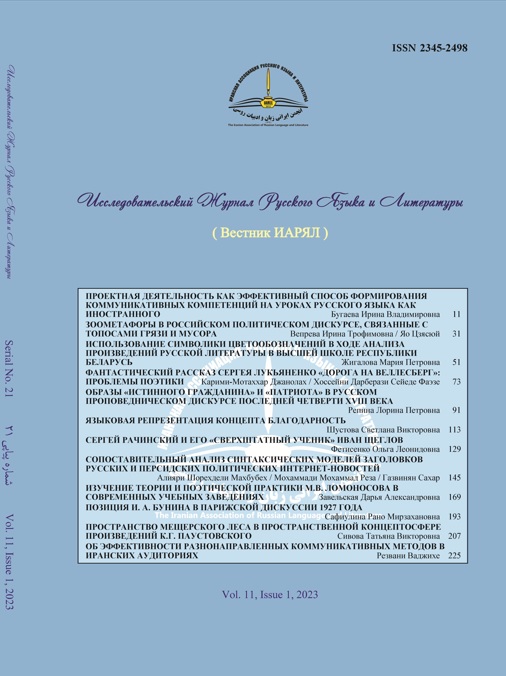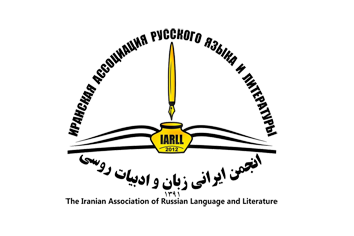ЗООМЕТАФОРЫ В РОССИЙСКОМ ПОЛИТИЧЕСКОМ ДИСКУРСЕ, СВЯЗАННЫЕ С ТОПОСАМИ ГРЯЗИ И МУСОРА
DOI:
https://doi.org/10.52547/iarll.21.2Ключевые слова:
Зоометафора, Концепт ГРЯЗЬ, Концепт МУСОР, «Нечистые» животные, отрицательная коннотация, морально-нравственные аспектыАннотация
В статье описан круг представителей животного мира, выделенных на основе ассоциативной смежности с топосами грязи и мусора. Среда обитания, привычки или поведение животных связаны с миром нечистого бытия. Бестиарий демонстрирует расчеловечивание политического мира путем приписывания политикам зооморфных черт. Зоометафоры объединены в рамках семантики, характеризующей морально-нравственные аспекты политического существования. Анализируемый бестиарий включает пять групп: дикие животные (шакалы и гиены), домашние животные (свинья), мелкие животные-грызуны (мыши, крысы), птицы (ворона), насекомые (муха, таракан, вошь, блоха, клоп). Выявлено, что конститутивную особенность зоосемантики составляет аксиологическая составляющая. Зооморфные наименования-характеристики направлены на дискредитацию государственной власти, резкое снижение образа политика и обладают яркой пейоративной окраской. Бестиарные моменты безнравственного поведения политиков на основе прямых ассоциаций с грязью (например, метафорический образ свиньи) не всегда главные в семиотике представленного зоомира. Так, в сближении масштаба мира насекомых и политиков концептуализируется ничтожность и незначительность партийной деятельности, которая обесценивает политическую жизнь.
Библиографические ссылки
- Агафонова О. И. (2011). Употребление метафор с зооморфным компонентом в англоязычном политическом дискурсе // Научные ведомости Белгород. гос. ун-та. Серия: Гуманитарные науки. № 6(101). С. 82–88.
- Алексеев А. В. (2019). Соотношение номинации и коннотации в синхронии и диахронии (на материале названий врановых) // Птица как образ, символ, концепт в литературе, культуре и языке: коллективная монография / Отв. ред. Смирнова. Москва: Книгодел. С. 376–381.
- Вайс Д. (2008). Паразиты, падаль, мусор. Образ врага в советской пропаганде // Политическая лингвистика. №1(24). С. 16–22.
- Ватутина А. С. (2014). Постмодернистский образ насекомого как квинтэссенция высокого и низкого: Д. Пригов, В. Пелевин, Л. Петрушевская // Вестник Нижегородского университета. №2(3). С. 219–223.
- Вознесенская М. М. (2014). Муха под микроскопом русской литературы (Достоевский vs. Толстой, Салтыков-Щедрин, Тургенев, Гончаров) // Коммуникативные исследования. Т. 8. №4. С. 825–850.
- Гудков Л. К. (2004). К проблеме негативной идентификации // Негативная идентичность. Статьи 1997‒2002 годов. Москва: Новое литературное обозрение, «ВЦИОМ-А», С. 262–299.
- Гура А. В. (1997). Символика животных в славянской народной традиции. Москва: Индрик, 910 с.
- Керимов Р. Д. (2013). Зоометафоры в языке немецкой политики (лингвокогнитивный аспект) // Вестник Перм. ун-та. Российская и зарубежная филология. № 2(22). С. 58–67.
- Красильникова П. Ю. (2021). Синтаксические закономерности реализации коннотаций зоонимов в поэтическом языке Саши Чёрного // Вестник Моск. гос. област. ун-та. Серия: Русская филология. № 4. С. 13–22.
- Рябов О. В. (2021). Бестиарий мировой политики: когнитивные, политические и социальные функции использования животных метафор // Символическое измерение военных и политических конфликтов (зарождение, протекание, деэскалация): Мат-лы науч. конф., Санкт-Петербург, 14–15 декабря 2021 года / Санкт-Петербург: Российский государственный педагогический университет им. А. И. Герцена, 2021. С. 82–86.
- Скляревская Г. Н. (1993). Метафора в системе языка. Санкт-Петербург: Наука, 150 с.
- Сумцов Н. Ф. (1890). Ворон в народной словесности (из «Этнографического обозрения», 1890, кн.1). Москва: Типография Е. Г. Потапова, 26 с.
- Терновская О. А. (1995). Блоха // Славянские древности. Этнолингвистический словарь / под ред. Н. И. Толстого. Т.1. Москва: Международные отношения, С. 196–197.
- Топоров В. Н. (2008). Муха // Мифы народов мира. Энциклопедия: Москва: Советская энциклопедия, С.699–700.
- Шестопал Е. Б., Новикова-Грунд М. В. (1996). Восприятие образов двенадцати ведущих российских политиков (психологический и лингвистический анализ // Полис. Политические исследования. № 5. С. 168–191.
Bibliography
- Agafonova O. I. (2011). Upotreblenie metafor s zoomorfnym komponentom v anglojazychnom politicheskom diskurse // Nauchnye vedomosti Belgorod. gos. un-ta. Serija: Gumanitarnye nauki. № 6(101). S. 82–88.
- Alekseev A. V. (2019). Sootnoshenie nominacii i konnotacii v sinhronii i diahronii (na materiale nazvanij vranovyh) // Ptica kak obraz, simvol, koncept v literature, kul'ture i jazyke: kollektivnaja monografija / Otv. red. Smirnova. Moskva: Knigodel. S. 376–381.
- Vajs D. (2008). Parazity, padal', musor. Obraz vraga v sovetskoj propagande // Politicheskaja lingvistika. №1(24). S. 16–22.
- Vatutina A. S. (2014). Postmodernistskij obraz nasekomogo kak kvintjessencija vysokogo i nizkogo: D. Prigov, V. Pelevin, L. Petrushevskaja // Vestnik Nizhegorodskogo universiteta. №2(3). S. 219–223.
- Voznesenskaja M. M. (2014). Muha pod mikroskopom russkoj literatury (Dostoevskij vs. Tolstoj, Saltykov-Shhedrin, Turgenev, Goncharov) // Kommunikativnye issledovanija. T. 8. №4. S. 825–850.
- Gudkov L. K. (2004). K probleme negativnoj identifikacii // Negativnaja identichnost'. Stat'i 1997‒2002 godov. Moskva: Novoe literaturnoe obozrenie, «VCIOM-A», S. 262–299.
- Gura A. V. (1997). Simvolika zhivotnyh v slavjanskoj narodnoj tradicii. Moskva: Indrik, 910 s.
- Kerimov R. D. (2013). Zoometafory v jazyke nemeckoj politiki (lingvokognitivnyj aspekt) // Vestnik Perm. un-ta. Rossijskaja i zarubezhnaja filologija. № 2(22). S. 58–67.
- Krasil'nikova P. Ju. (2021). Sintaksicheskie zakonomernosti realizacii konnotacij zoonimov v pojeticheskom jazyke Sashi Chjornogo // Vestnik Mosk. gos. oblast. un-ta. Serija: Russkaja filologija. № 4. S. 13–22.
- Rjabov O. V. (2021). Bestiarij mirovoj politiki: kognitivnye, politicheskie i social'nye funkcii ispol'zovanija zhivotnyh metafor // Simvolicheskoe izmerenie voennyh i politicheskih konfliktov (zarozhdenie, protekanie, dejeskalacija): Mat-ly nauch. konf., Sankt-Peterburg, 14–15 dekabrja 2021 goda / Sankt-Peterburg: Rossijskij gosudarstvennyj pedagogicheskij universitet im. A. I. Gercena, 2021. S. 82–86.
- Skljarevskaja G. N. (1993). Metafora v sisteme jazyka. Sankt-Peterburg: Nauka, 150 s.
- Sumcov N. F. (1890). Voron v narodnoj slovesnosti (iz «Jetnograficheskogo obozrenija», 1890, kn.1). Moskva: Tipografija E. G. Potapova, 26 s.
- Ternovskaja O. A. (1995). Bloha // Slavjanskie drevnosti. Jetnolingvisticheskij slovar' / pod red. N. I. Tolstogo. T.1. Moskva: Mezhdunarodnye otnoshenija, S. 196–197.
- Toporov V. N. (2008). Muha // Mify narodov mira. Jenciklopedija: Moskva: Sovetskaja jenciklopedija, S.699–700.
- Shestopal E. B., Novikova-Grund M. V. (1996). Vosprijatie obrazov dvenadcati vedushhih rossijskih politikov (psihologicheskij i lingvisticheskij analiz // Polis. Politicheskie issledovanija. № 5. S. 168–191.
Загрузки
Опубликован
Как цитировать
Выпуск
Раздел
Лицензия
Copyright (c) 2023 Исследовательский Журнал Русского Языка и Литературы

Это произведение доступно по лицензии Creative Commons «Attribution» («Атрибуция») 4.0 Всемирная.
![]()
"Creative Commons Attribution 4.0 International (CC-BY 4.0)"


